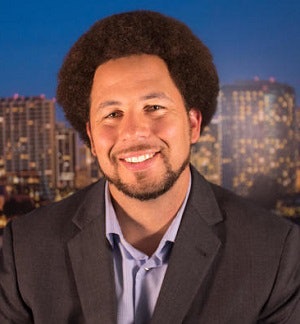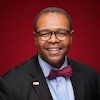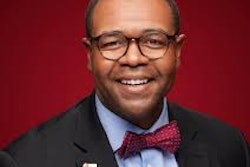It is no secret that the demographic makeup of students enrolled in American colleges and universities today is far more diverse than in prior eras. According to the most recent Digest of Education Statistics, White students accounted for 82.1 percent of undergraduates in 1976 yet represented 53.8 percent of the student enrollment four decades later. This shift has been counterbalanced with a growing diversity of students, particularly those of Latinx descent, who grew from 3.7 percent to 18.7 percent in this same time frame.
 Dr. J. Luke Wood
Dr. J. Luke WoodThe growth in student diversity has been adjoined with an alphabet soup of essential federal designations for minority serving institutions such as Hispanic serving institutions (HSIs), predominantly Black institutions (PBIs) and Asian American Native American Pacific Islander serving institutions (AANAPISIs).
In contrast, the representation of diversity within the professoriate is disproportionately White. Roughly speaking, for every one White faculty member there are 16 White students. In contrast, for every one Black and Latinx faculty member there are 49 Black students and 84 Latinx students, respectively. These data have direct implications for student advising, same-race role models, mentorship, cultural relevance and, ultimately, student success.
Given this, diversifying the faculty remains one of the most central challenges facing American higher education today. This is not to say that White faculty cannot be successful with students of color. However, it is certainly important for students to see people who look like them at some point in their academic career. Fortunately, much has been written about strategies and practices that can promote a more robust applicant pool and a fairer selection process.
Many institutions continue to employ the Association of American Colleges and Universities guidebook on Diversifying the Faculty. Written by Dr. Caroline Turner in 2002, this resource still provides relevant recommendations for search committees to consider before, during and after the search to recruit and retain minoritized faculty. Some of the most critical recommendations include advertising in diverse outlets (like DiverseJobs), ensuring that the search committee is diverse and employing inclusive language on job descriptions. Additional insights can also be drawn from the works of innumerable scholars such as Christine Stanley, Frank Tuitt, Ben Baez, Daryl Smith and Barbara Johnson.
As a scholar who has also written on this topic and as a practitioner who has supported institutions in building strategies for addressing the paucity of diverse faculty, I believe that there are four key research-based strategies within the pantheon of recommendations that are basic building blocks for all institutions to enact.
Implicit Bias Training
Every search committee, in advance of every search, should be trained on the role of implicit bias in all elements of the selection process. This includes the role of bias in the drafting of the job description, outreach to potential candidates, segregation of search committee networks, initial screening of applications, semi-finalist interviews and on-campus interviews.
Ultimately, trainings on implicit bias in the hiring process should be conducted in person and should occur before each and every search. In addition, trainings should employ hands-on examples and case scenarios and provide tangible steps that can be used to make better decisions. Two keys strategies should include telling search committees to “slow down” when reviewing applications and consistently question what is meant by vague words such as “fit,” “likeable” and “resonate” (e.g., you say that the candidate resonates with you, why is that?).
I generally find that most faculty are “good people” who want to do the right thing, but simply need a greater awareness of how their biases influence the search process and selection of candidates.
Certification of Applicant Pools
When people reach out to their colleagues and professional organizations to advertise new position openings, it is often the case that their networks are a reflection of their own backgrounds. As a result, search committees consistently produce candidates that are a reflection of them in terms of demographic backgrounds, theoretical orientation and research priorities. For many, this is not designed to intentionally exclude but simply a function of who they are and who they know.
Given this, all search committees should be provided with feedback on the diversity within the applicant pools and the semi-finalist lists. In an ideal situation, pools should be certified to move forward at each stage based on whether the pool is reflective of relevant degree-holders within the field. Otherwise, the search should be halted.
For example, if 5 percent of an applicant pool is representative of candidates of color yet 17 percent of terminal degree-holders in the same field are people of color, then the committee should be tasked with additional recruitment until the pool is more reflective of the discipline.
Diversity Advocates on Each Committee
All institutions should have a pool of diversity advocates who have been trained extensively in equitable hiring practices and policies who can help support the search process. These advocates should be certified annually and should sit on each search committee to help reinforce equitable decision-making. They can intercede when criteria are applied more rigorously to candidates of color, ask follow-up questions, probe sense-making when vague words (e.g., fit, likeable) are used and help reinforce a hypervigilance about implicit bias throughout the search process.
It is certainly the case that people act differently when they are being monitored, not because they have poor intentions, but because we are human and bias is a core element of the human condition.
Inclusive Job Search Criteria
At this point, many institutions of higher education have within their mission statement a commitment to serving diverse student populations. Many institutions have initiatives and efforts that are designed to promote the achievement of students from underserved backgrounds. However, this commitment is rarely seen within the job criteria. All searches should have criteria that prioritize candidates who have demonstrated experience in research, teaching, and/or service to historically underrepresented and underserved communities.
This does not necessarily mean that the successful candidate will necessarily be a person of color, but this practice increases the likelihood of their representation in the pool and ensures that all candidates – regardless of race – have a track record that can help advance the priorities and needs of the institution.
In tandem, the aforementioned criteria can be used to improve the search pool and decision-making process to ensure that the best and most qualified faculty are being hired.
Dr. J. Luke Wood is Distinguished Professor of Education and Chief Diversity Officer at San Diego State University. You can follow him on Twitter @DrLukeWood


















